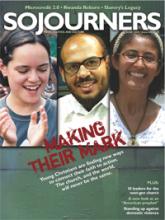An elderly Zambian woman pulled out a Chutes and Ladders game and showed it to her visitors. “This is my life,” she said. “The loan you gave me really helped me, but where are you when a disaster hits?”
One of the visitors was Richard Leftley, an insurance executive who was in Zambia to learn about Opportunity International and its program of making small loans to local entrepreneurs. He learned that many recipients of Opportunity loans were only “one or two disasters away from abject poverty,” Leftley told Sojourners.
“I became convinced that God would have me do something else with my skills, and convinced that the poor would want insurance,” Leftley said. So he joined the staff of Opportunity and is now president of its Micro Insurance Agency.
Leftley’s work is part of a new trend in microfinance. For the first 30 years after Opportunity was established in 1971, small loans to entrepreneurs in developing countries were the centerpiece of its program. With initial loans of as little as $50, Opportunity’s borrowers—84 percent of whom are women—can expand their businesses, perhaps by buying a sewing machine or purchasing stock for a store. After paying the initial loan back, a borrower can request another loan and then another, each larger than the one before. Some are eventually able to hire employees.
But microlending has always had its limits. Borrowers and their employees might have nowhere to save their earnings. The costs of a funeral—as high as six months of disposable income, Leftley said—can wipe out a family’s savings. Crop failures can make it impossible for farmers to pay back loans. So in the late 1990s, Opportunity began to open new paths in microfinance.
Read the Full Article

